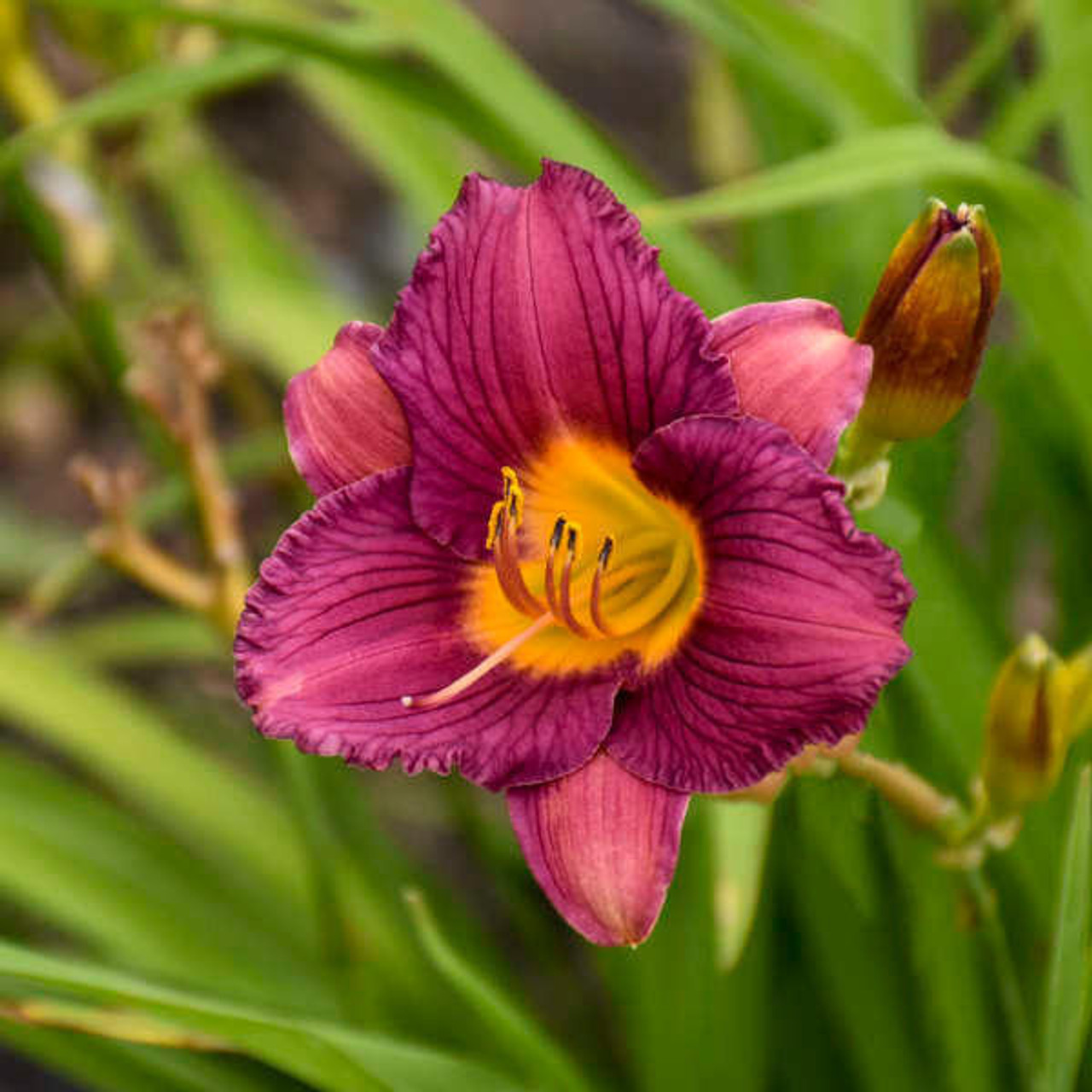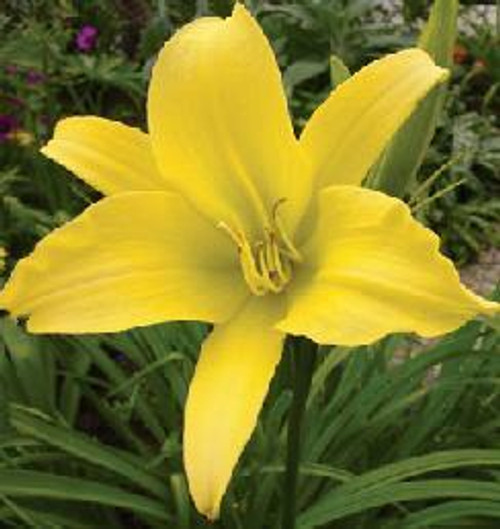Product Description
Hemerocallis - 'Purple de Oro' (DeGroot, 2000) Single Fan bare root plant
- Also known as 'Razzmatazz'
- 2½", medium purple flowers and a bright yellow throat
- Petals have narrow pie crust edges, dark purple veining, and paler purple midribs; smooth-edged sepals have white tips
- Early Midseason Bloomer, blooming in early July.
- Rebloomer, producing a second set of flowers.
- Dormant foliage.
- Diploid with 22 chromosomes.
Height: 20 Inches
Spread: 18.0-24.0 Inches
Hardiness Zones: 3,4,5,6,7,8,9
Flower Color: Purple shades
Foliage Color: Green shades
Full Sun (> 6 hrs. Direct Sun) - Part Shade (4-6 hrs. Direct Sun)
Low to Average Water Needs
Poor to Fertile Soil Quality
Bloomtime: Midsummer, Rebloomer
Attracts Butterflies and Hummingbirds
Bee Friendly
Rabbit Resistant
Growth Rate: Medium
Border Plant, Container, Easy To Grow, Fragrant Flowers, Mass Planting, Salt Tolerant
Hemerocallis 'Purple de Oro' is a charming and reliable daylily known for its beautiful purple blooms and reblooming habit. Here is a breakdown of its key features:
Hemerocallis 'Purple de Oro' (Purple de Oro Daylily)
- Type: Herbaceous Perennial
- Hardiness Zones: 3-9 (very adaptable)
- Height: 18-20 inches
- Spread: 18-24 inches
- Flowers: 2.5-3 inch, ruffled, reddish-purple flowers with a yellowish-green throat
- Bloom Time: Early summer to frost (reblooming)
- Foliage: Dormant (dies back in winter), grass-like
- Light: Full sun to partial shade
- Soil: Adaptable to various soil types, but prefers well-drained soil
- Water: Drought-tolerant once established
- Uses: Borders, edging, mass plantings, container plantings
Why 'Purple de Oro' is a Great Choice
- Beautiful Blooms: The vibrant purple flowers add a touch of color to the garden for a long period.
- Reblooming: Produces multiple flushes of flowers throughout the growing season.
- Easy Care: Daylilies are known for being low-maintenance and adaptable.
- Versatile: Works well in a variety of garden settings.
- Attracts Pollinators: The flowers attract butterflies and hummingbirds.
How to Grow 'Purple de Oro'
- Planting: Plant in spring or fall. Space plants about 18-24 inches apart.
- Soil: Amend the soil with compost or other organic matter to improve drainage and fertility.
- Light: Choose a location with full sun to partial shade.
- Watering: Water regularly until established, then only during prolonged dry spells.
- Fertilizing: Apply a balanced fertilizer in spring.
- Mulching: Apply a layer of mulch around the plants to retain moisture and suppress weeds.
- Deadheading: Remove spent flowers to encourage more blooms.
- Dividing: Divide clumps every 3-4 years to prevent overcrowding and rejuvenate plants.
Potential Problems
- Slugs and Snails: Can be occasional pests.
- Crown Rot: Can be a problem in poorly drained soil.
- Aphids: Can be treated with insecticidal soap.
Hemerocallis 'Purple de Oro' is a great choice for gardeners looking for a beautiful, low-maintenance, and long-blooming perennial. Its reblooming habit ensures a continuous display of vibrant purple flowers throughout the growing season.
Other Details
The most important part of the plant is its root system. Healthy roots are the foundation of a healthy, vibrant plant. The type of plug container used is based on the specific needs of the plants. Perennials offered as bare root traditionally perform better when planted as bare root.Planted in a specialized mix, potted plants have well established root systems. Top growth stage will vary depending on the current life cycle and time of year when shipped. In Winter and early Spring dormant plants may be shipped. Dormant plants may be planted right away, even before the last frost date.
Most bare root varieties are field grown for at least one season, though Hemerocallis and Hosta are grown for two seasons. The bulk of the soil is removed during the harvesting process and the tops of most varieties are trimmed back to the crown. They are graded, packed in shredded aspen or sphagnum moss and stored in freezers until ready to be shipped.
See our Container Sizes and Bare Root Perennials pages for more information.
Plant information and care is provided in the Overview section, Plant Genus Page and general information is provided in the Planting Care & Guides. Additional questions can be asked on each Plant page.
Plant Spacing: Using the maximum mature spread or width of a plant to guide spacing, ensures space to grow to full size. To fill an area sooner, plant them closer together. Just remember, future thinning or transplanting may be needed.
Water: Keep a close eye on newly planted perennials, especially throughout the first growing year. Most early plant loss is due to too much or too little water!




















